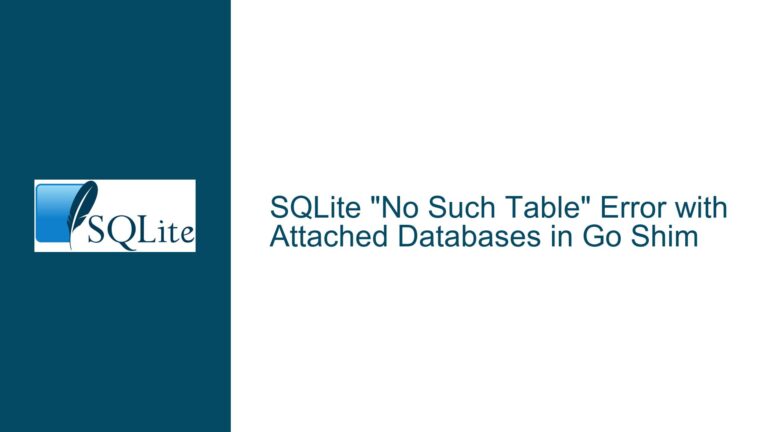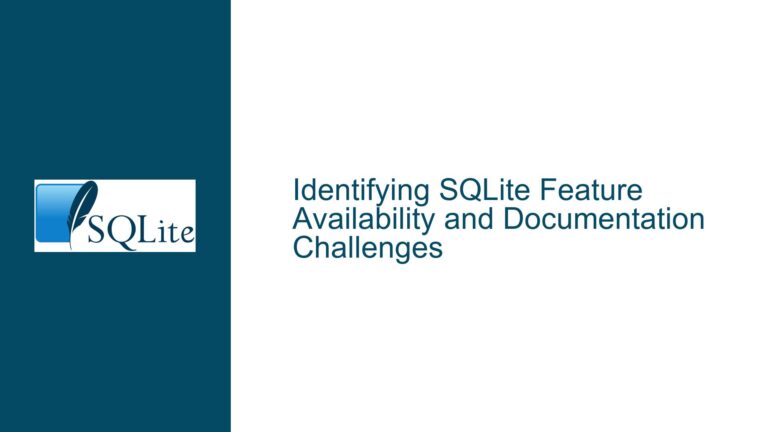SQLite BEGIN IMMEDIATE Fails with Read-Only Attached Databases
Read-Only Attached Databases and Transaction Locking Behavior
When working with SQLite, attaching a read-only database to a connection can lead to unexpected behavior when attempting to initiate an immediate or exclusive transaction. Specifically, the BEGIN IMMEDIATE or BEGIN EXCLUSIVE commands may fail with an error indicating an attempt to write to a read-only database. This issue arises due to the way SQLite handles locks on attached databases during transaction initiation.
In a typical scenario, a standard deferred transaction (BEGIN) works without issues because it does not immediately acquire locks on the attached databases. Instead, locks are only taken when a read or write operation is performed on the attached database. However, immediate and exclusive transactions require acquiring locks at the start of the transaction to ensure data consistency and isolation. When an attached database is marked as read-only, SQLite attempts to acquire a write lock, which is inherently incompatible with the read-only nature of the database. This results in the "attempt to write a readonly database" error.
The behavior is further complicated when dealing with immutable databases. According to the SQLite documentation, immutable databases are supposed to disable all locking mechanisms, as they are guaranteed not to change. However, even in such cases, BEGIN IMMEDIATE or BEGIN EXCLUSIVE commands fail, suggesting that the locking mechanism is still being invoked despite the immutable flag.
Lock Acquisition Logic in Immediate and Exclusive Transactions
The root cause of this issue lies in the lock acquisition logic within SQLite’s transaction management system. When a transaction is initiated with BEGIN IMMEDIATE or BEGIN EXCLUSIVE, SQLite attempts to acquire locks on all attached databases, including those marked as read-only or immutable. This behavior is controlled by the sqlite3BeginTransaction function in the SQLite source code.
In the current implementation, the sqlite3BeginTransaction function does not differentiate between read-only and writable databases when acquiring locks for immediate or exclusive transactions. Instead, it unconditionally attempts to acquire a write lock on all attached databases, regardless of their read-only status. This leads to the observed error when a read-only database is attached.
The issue is exacerbated by the fact that immutable databases, which should theoretically bypass all locking mechanisms, are still subjected to the same lock acquisition logic. This suggests a potential oversight in the handling of immutable databases within the transaction management system.
Modifying Lock Acquisition for Read-Only and Immutable Databases
To address this issue, the lock acquisition logic in the sqlite3BeginTransaction function needs to be modified to account for read-only and immutable databases. Specifically, the function should only attempt to acquire write locks on databases that are writable. For read-only and immutable databases, the function should either skip lock acquisition entirely or acquire a read lock instead.
The proposed modification involves changing the OP_Transaction operation’s second parameter (P2) to 0 if the underlying B-tree is read-only. This change ensures that no write locks are attempted on read-only databases, preventing the "attempt to write a readonly database" error. The modified code would look like this:
void sqlite3BeginTransaction(Parse *pParse, int type){
sqlite3 *db;
Vdbe *v;
int i;
assert( pParse!=0 );
db = pParse->db;
assert( db!=0 );
if( sqlite3AuthCheck(pParse, SQLITE_TRANSACTION, "BEGIN", 0, 0) ){
return;
}
v = sqlite3GetVdbe(pParse);
if( !v ) return;
if( type!=TK_DEFERRED ){
for(i=0; i<db->nDb; i++){
sqlite3VdbeAddOp2(v, OP_Transaction, i, sqlite3BtreeIsReadonly(db->aDb[i].pBt) ? 0 : (type==TK_EXCLUSIVE)+1);
sqlite3VdbeUsesBtree(v, i);
}
}
sqlite3VdbeAddOp0(v, OP_AutoCommit);
}
In this modified version, the OP_Transaction operation’s P2 parameter is set to 0 if the underlying B-tree is read-only. This ensures that no write locks are attempted on read-only databases, allowing the BEGIN IMMEDIATE or BEGIN EXCLUSIVE commands to proceed without errors.
Testing the Modified Lock Acquisition Logic
After implementing the proposed changes, it is essential to thoroughly test the modified lock acquisition logic to ensure that it behaves as expected in various scenarios. The following test cases should be considered:
Standard Deferred Transaction with Read-Only Attached Database: Verify that a standard deferred transaction (
BEGIN) works correctly when a read-only database is attached. The transaction should not attempt to acquire any locks on the read-only database until a read or write operation is performed.Immediate Transaction with Read-Only Attached Database: Test the
BEGIN IMMEDIATEcommand with a read-only attached database. The transaction should acquire a read lock on the read-only database instead of attempting to acquire a write lock. The transaction should proceed without errors.Exclusive Transaction with Read-Only Attached Database: Test the
BEGIN EXCLUSIVEcommand with a read-only attached database. Similar to the immediate transaction, the exclusive transaction should acquire a read lock on the read-only database and proceed without errors.Immutable Database with Immediate Transaction: Verify that the
BEGIN IMMEDIATEcommand works correctly with an immutable attached database. The transaction should bypass lock acquisition entirely, as immutable databases are guaranteed not to change.Immutable Database with Exclusive Transaction: Test the
BEGIN EXCLUSIVEcommand with an immutable attached database. The transaction should also bypass lock acquisition and proceed without errors.Mixed Writable and Read-Only Databases: Test scenarios where multiple databases are attached, some of which are writable and others are read-only. Verify that the transaction logic correctly differentiates between writable and read-only databases, acquiring appropriate locks for each.
Potential Impact of the Proposed Changes
The proposed changes to the lock acquisition logic have several potential impacts on SQLite’s behavior:
Improved Compatibility with Read-Only Databases: The modified logic ensures that
BEGIN IMMEDIATEandBEGIN EXCLUSIVEcommands work correctly with read-only attached databases, improving compatibility and reducing unexpected errors.Consistent Behavior with Immutable Databases: The changes ensure that immutable databases are handled consistently, bypassing lock acquisition as intended. This aligns with the documented behavior of immutable databases and prevents unnecessary errors.
Enhanced Performance: By avoiding unnecessary lock acquisition on read-only and immutable databases, the modified logic can improve transaction performance, particularly in scenarios where multiple read-only databases are attached.
Backward Compatibility: The proposed changes are backward compatible with existing applications that do not use read-only or immutable databases. Applications that rely on the current behavior will continue to function as expected.
Alternative Approaches
While the proposed modification to the sqlite3BeginTransaction function addresses the issue, there are alternative approaches that could be considered:
Explicit Locking Control: Introduce a new SQLite pragma or command that allows users to explicitly control lock acquisition behavior for attached databases. This would provide more flexibility but could also increase complexity.
Database-Level Locking Flags: Add new flags to the
ATTACH DATABASEcommand that specify the locking behavior for the attached database. For example, a flag could indicate that no locks should be acquired on the attached database, regardless of its read-only status.Transaction-Level Locking Control: Allow users to specify lock acquisition behavior at the transaction level. For example, a
BEGIN IMMEDIATEcommand could include an option to skip lock acquisition on read-only databases.
Each of these alternatives has its own trade-offs, and the choice of approach would depend on the specific requirements and constraints of the application.
Conclusion
The issue of BEGIN IMMEDIATE and BEGIN EXCLUSIVE commands failing with read-only attached databases is a nuanced problem that stems from SQLite’s lock acquisition logic. By modifying the sqlite3BeginTransaction function to account for read-only and immutable databases, the issue can be resolved, improving compatibility and consistency. Thorough testing is essential to ensure that the modified logic behaves as expected in various scenarios. Alternative approaches provide additional flexibility but may introduce complexity. Ultimately, the proposed changes offer a straightforward solution that aligns with SQLite’s design principles and enhances its usability in scenarios involving read-only and immutable databases.






